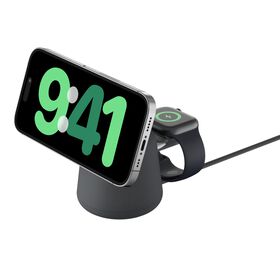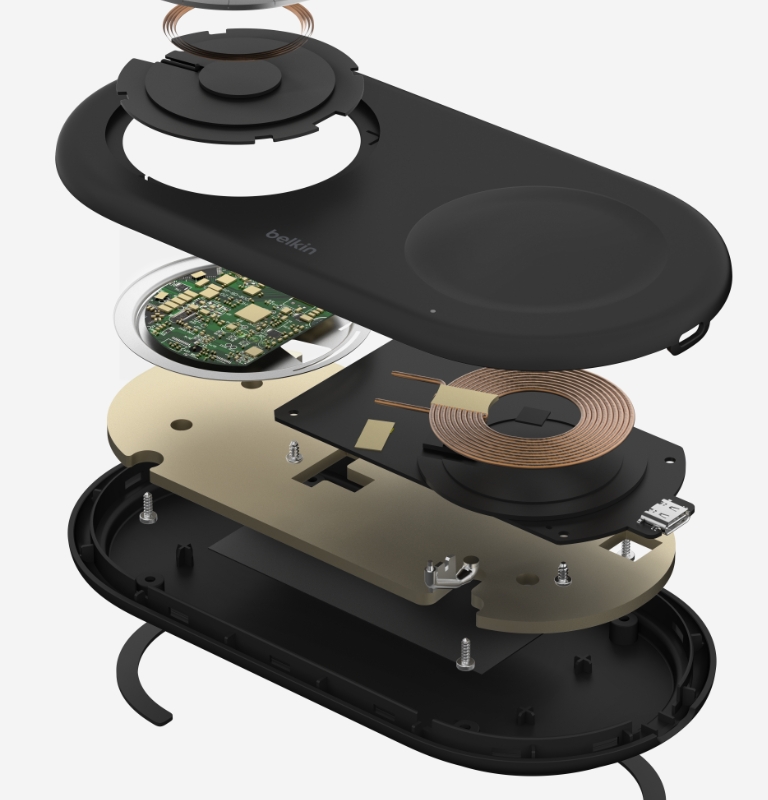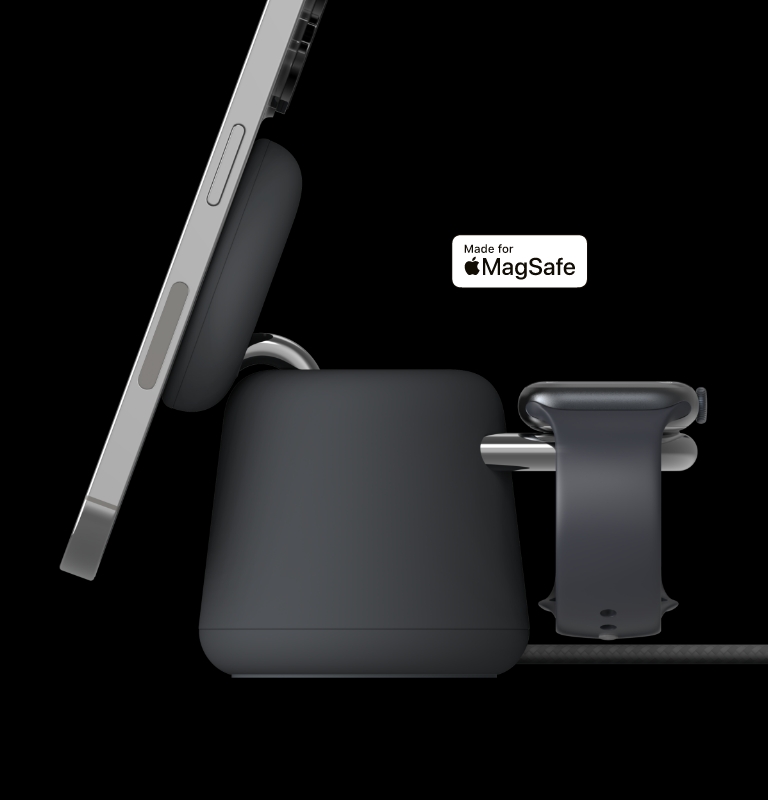Scopri di più sui caricabatterie wireless per telefono.
Domande frequenti sui caricabatterie wireless
I caricabatterie wireless per telefono permettono di ricaricare il telefono senza dover usare un cavo. Basta posizionare il dispositivo su un tappetino o supporto di ricarica, e il dispositivo inizierà a ricaricarsi automaticamente grazie al campo elettromagnetico. Un chip controlla il processo di ricarica per assicurare che sia sicuro e non danneggi il dispositivo. Scopri di più sul funzionamento qui.
Né la ricarica magnetica o i caricabatterie wireless rovinano generalmente la batteria dei dispositivi. Con il trascorrere del tempo, la batteria va incontro all'usura dovuta ai continui scaricamenti e ricariche. Lasciare i dispositivi sempre in ricarica può danneggiare la loro batteria. È consigliabile scollegare il dispositivo al termine della ricarica. Scopri di più sulla sicurezza qui.
Dispositivi Apple: iPhone 8 e successivi
I dispositivi Samsung: Telefoni Galaxy Note: Galaxy Note20 5G, Note20 Ultra 5G, Note10+, Note10, Note9, Note8 e Note 5, Telefoni Galaxy S: S23 series, S22 series, S21 series, S20 series, S10 series, S9 series, S8 series, S7 series, and S6 series, Telefoni pieghevoli: Galaxy Z Fold, Z Fold2, Z Fold3, Z Fold4, Z Flip, Z Flip 5G, Z Flip3 e Z Flip4
Dispositivi Google Pixel: Pixel 3, Pixel 3 XL, Pixel 4, Pixel 4 XL, Pixel 5, Pixel 6, Pixel 6Pro, Pixel 7, Pixel 7 Pro
Per utilizzare un tappetino di ricarica wireless, collegalo innanzitutto ad una fonte di alimentazione e appoggia su di esso un dispositivo compatibile, accertandoti che sia posizionato al centro e allineato in base alle istruzioni fornite. Attendi che la ricarica si avvii (ciò potrebbe essere indicato da un LED o altro indicatore). È importante notare che non tutti i dispositivi sono compatibili con tutti i caricabatterie wireless. Verifica perciò le specifiche del tuo dispositivo che accertarne la compatibilità con il caricabatteria e il relativo standard di ricarica.
I tappetini di ricarica utilizzano la tecnologia di ricarica a induzione per trasferire l'energia in modalità wireless dal caricabatteria al dispositivo da ricaricare. La tecnologia sfrutta il campo elettromagnetico creato da due bobine, una integrata nel caricabatteria e l'altra situata nel dispositivo da ricaricare. La maggior parte degli caricabatterie wireless utilizza i moduli MagSafe, Qi o Qi2. La compatibilità, la velocità e potenza di ricarica e altre specifiche variano in base alla tecnologia di ricarica wireless utilizzata.
I supporti di ricarica wireless sono simili ai tappetini di ricarica, ma permettono di impostare il dispositivo su varie angolazioni per consentire la visualizzazione di contenuti durante la ricarica. Utilizzano la ricarica a induzione, che trasferisce l'energia in modalità wireless dal caricabatteria al dispositivo da ricaricare. Il caricabatteria integra una bobina in grado di creare un campo elettromagnetico, che viene a sua volta rilevato dalla bobina presente nel dispositivo da ricaricare. La maggior parte dei supporti di ricarica wireless utilizza lo standard Qi, che ottimizza il processo di ricarica, regolando la potenza e la velocità di ricarica, e permette di visualizzare contenuti sul dispositivo mentre è in ricarica.
La maggior parte dei nuovi modelli di iPhone integra capacità di ricarica wireless. Ecco un elenco dei modelli di iPhone che supportano questa funzionalità:
- iPhone 8 e successivi: tutti i modelli dall'iPhone 8 in poi supportano la ricarica wireless.
- iPhone X e successivi: ciò include iPhone X, XS, XS Max, XR e modelli più nuovi.
- iPhone 11 series: tutti i modelli, inclusi iPhone 11, 11 Pro e 11 Pro Max.
- iPhone 12 series: tutti i modelli, inclusi iPhone 12, 12 mini, 12 Pro e 12 Pro Max. Questi smartphone supportano anche la ricarica wireless con MagSafe.
- iPhone 13 series: tutti i modelli, inclusi iPhone 13, 13 mini, 13 Pro e 13 Pro Max, supportano MagSafe.
- iPhone 14 series: tutti i modelli, inclusi iPhone 14, 14 Plus, 14 Pro e 14 Pro Max, supportano MagSafe.
Sì, numerosi telefoni Samsung supportano la ricarica wireless. Ecco un elenco dei modelli Samsung che generalmente supportano la ricarica wireless:
- Galaxy S Series: Galaxy S6 e successivi: a partire dal Galaxy S6, tutti i modelli inclusi S6 Edge, S7, S7 Edge, S8, S8+, S9, S9+, S10e, S10, S10+, S20, S20+, S21, S21 Ultra, S22, S22+, S22 Ultra, S23, S23+ e S23 Ultra supportano la ricarica wireless.
- Galaxy Note Series: Galaxy Note 5 e successivi: tutti i modelli inclusi Note 8, Note 9, Note 10, Note 10+, Note 20 e Note 20 Ultra supportano la ricarica wireless.
- Galaxy Z Series: Galaxy Z Fold e Z Flip series: i modelli tra cui Galaxy Z Fold 2, Z Fold 3, Z Fold 4, Z Flip, Z Flip 5 e successivi supportano la ricarica wireless.
- Galaxy A Series: Modelli selezionati: alcuni modelli di Galaxy A series di fascia alta, come Galaxy A80, A90 e A91, supportano la ricarica wireless, ma molti modelli di fascia media non sono compatibili con questa tecnologia.
- Galaxy M Series: supporto limitato: Generalmente, la serie Galaxy M, nota per il suo prezzo conveniente, non include la ricarica wireless nei suoi modelli.
Sì, numerosi telefoni Android supportano la ricarica wireless. La funzionalità è comune nei modelli di fascia media e alta. Ecco un elenco dei telefoni Android con ricarica wireless:
- Google Pixel Series: Pixel 3 e successivi: tutti i modelli di Pixel, dal Pixel 3, Pixel 3 XL, Pixel 4, Pixel 4 XL, Pixel 5, Pixel 6, Pixel 6 Pro, Pixel 7 e Pixel 7 Pro supportano la ricarica wireless.
- Samsung Galaxy Series: Galaxy S Series: a partire dal Galaxy S6, la maggior parte dei modelli della serie S supporta la ricarica wireless.
- Galaxy Note Series: a partire dal Note 5 e versioni successive, incluso il Note 20 Ultra.
- Galaxy Z Series: include vari modelli come il Galaxy Z Fold e la serie Z Flip.
- OnePlus: OnePlus 8 Pro e successivi: i modelli OnePlus 8 Pro, OnePlus 9 Pro e OnePlus 10 Pro supportano la ricarica wireless. Alcuni modelli precedenti non la supportano.
- Xiaomi: Mi Mix 4 e successivi: i modelli Mi Mix 4 e alcuni altri modelli di fascia alta, come Mi 11 e Mi 11 Ultra, supportano la ricarica wireless
- Sony: Xperia 1 e successivi: i modelli quali Xperia 1 II, Xperia 1 III e i più recenti telefoni Xperia supportano la ricarica wireless.
- Oppo: Find X Series: i modelli quali Oppo Find X3 Pro supportano la ricarica wireless.
- Huawei: P40 Pro e successivi: Huawei P40 Pro, Mate 40 Pro e simili modelli di fascia alta supportano la ricarica wireless.
- Altri marchi: LG: alcuni modelli quali LG V30, V35, V40 e G7 ThinQ supportano la ricarica wireless, sebbene LG non produca più smartphone. Asus: modelli selezionati, quali ROG Phone 5, supportano la ricarica wireless.
Quando si confrontano i caricabatterie wireless per iPhone e telefoni Samsung, ci sono diversi fattori da considerare, inclusi la compatibilità, la velocità e potenza di ricarica, il design e altre specifiche. Ecco alcuni punti da tenere a mente:
1. Compatibilità
- iPhone: standard Qi e MagSafe (per iPhone 12 e versioni successive). MagSafe offre un migliore allineamento e una potenza di ricarica di 15 W.
- Telefoni Samsung: standard Qi. La maggior parte degli modelli supporta una potenza fino a 10 W, mentre alcuni fino a 15 W di ricarica wireless rapida con caricabatterie Samsung.
2. Velocità e potenza di ricarica
- iPhone: fino a 7,5 W con caricabatterie Qi standard. Fino a 15 W con MagSafe.
- Telefoni Samsung: fino a 10 W con caricabatterie Qi standard. Fino a 15 W con caricabatterie wireless rapidi Samsung.
3. Design e caratteristiche
- Caricabatterie MagSafe per iPhone: allineamento magnetico, design raffinato e integrazione con altri accessori MagSafe.
- Caricabatterie wireless Samsung: vari tipi di design (tappetini e supporti), alcuni con funzionalità aggiuntive come ventole di raffreddamento e capacità di ricaricare molteplici dispositivi nello stesso istante.
4. Prezzo
- Caricabatterie MagSafe: il prezzo è generalmente più alto per via della tecnologia proprietaria.
- Caricabatterie wireless Samsung: il prezzo è variabile; sono disponibili anche a prezzi competitivi con funzionalità aggiuntive.
I caricabatterie wireless rapidi dipendono dal dispositivo e dall'alimentatore utilizzato. Ecco una panoramica generale:
1. Ricarica wireless standard
- iPhone: fino a 7,5 W usando caricabatterie Qi compatibili.
- Telefoni Samsung: di solito fino a 10 W usando caricabatterie Qi compatibili, sebbene alcuni modelli siano in grado di supportare una maggiore potenza.
2. Ricarica wireless rapida
- iPhone: fino a 15 W con caricabatterie MagSafe di Apple per iPhone 12 e versioni successive.
- Telefoni Samsung: fino a 15 W con caricabatterie wireless rapidi di marchio Samsung, come quelli per Galaxy S21 Ultra o Note 20 Ultra.
Riepilogo velocità di ricarica
- Standard per iPhone: 7,5 W
- MagSafe per iPhone: fino a 15 W
- Standard per dispositivi Samsung: fino a 10 W
- Ricarica rapida per Samsung: fino a 15 W
Nota: la velocità di ricarica attuale dipende da vari fattori, quali lo spessore della custodia del telefono, l'allineamento sul caricabatteria e la potenza in uscita del caricabatteria. Scopri di più sulla ricarica wireless rapida.















